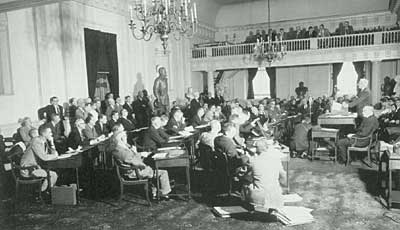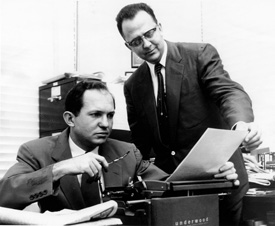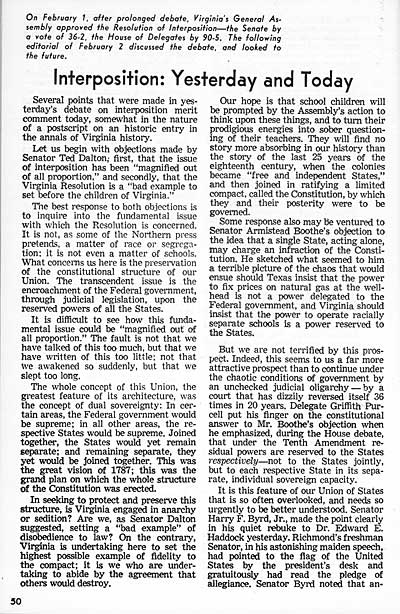
What Was Brown V. Board of Education?
The Prince Edward Case
and the Brown Decision
The State Responds:
Massive Resistance
Virginians Respond: Library of Virginia Documents
Additional Resources:
Brown v. Board of Education:
Selected Published Materials
at the Library of Virginia (pdf)
"If we can organize the Southern States for massive resistance to this order I think that in time the rest of the country will realize that racial integration is not going to be accepted in the South." With these words, Senator Harry Flood Byrd launched Massive Resistance, a deliberate campaign of delay and obfuscation. As head of the commonwealth's most powerful political organization, known as the "Byrd Machine," Byrd, a former governor (1926-1930), orchestrated Virginia's response to the Brown decision. Massive Resistance was intended to slow to a crawl attempts to integrate Virginia's schools generally and to minimize the effects of integration where it did occur.
![]() Governor Thomas B. Stanley responds to the United States Supreme Court decision in Brown v. Board of Education on WRVA Radio, May 14, 1954 (2:38)
Governor Thomas B. Stanley responds to the United States Supreme Court decision in Brown v. Board of Education on WRVA Radio, May 14, 1954 (2:38)
See the Library's exhibition Radio in Virginia for details on these recordings.
Although Stanley's message in this address was essentially "let's wait and see," he would soon espouse Byrd's all-out Massive Resistance.
The Initial Reaction: 1954-56
Agreeing with Senator Byrd, Governor Thomas Bahnson Stanley appointed a commission in August 1954 to determine possible options for defying the Brown decision. After meeting for more than a year, the Gray Commission, named for State Senator Garland Gray, proposed in November 1955,
- that laws concerning school attendance be amended so that no child
would be required to attend an integrated school,
- that funds be allocated as tuition grants for parents who opposed
schools comprised of white and black students, and
- that local school boards be authorized to assign white and African American students to particular schools.
This recommendation later became the statewide agency Pupil Placement Board that had the power to assign students to schools and approve requests for transfer.
In January 1956 white Virginians overwhelmingly supported a referendum to call a constitutional convention. After months of debates in the General Assembly, Governor Stanley ruled out control of anti-integration efforts at the local level and proposed to deny state appropriations to schools that integrated. Gray and the other commission members repudiated their report (which recommended what the Governor was proposing) and supported his plan. Massive Resistance became enshrined in the new state constitution. Virginians reacted to these decisions by petitioning and corresponding with Governor Stanley and local and state leaders.
![]() Lester Banks, executive secretary of the Virginia NAACP, testifies at the General Assembly's hearing on public school integration carried on
WRVA Radio, September 5, 1956 (1:10).
Lester Banks, executive secretary of the Virginia NAACP, testifies at the General Assembly's hearing on public school integration carried on
WRVA Radio, September 5, 1956 (1:10).
See the Library's exhibition Radio in Virginia for details on these recordings.

The General Assembly Extra Session 1956. Photographs. House of Delegates, Convention of 1956.
Interposition
Opponents of the Brown ruling and integration used the doctrine of interposition, which argued that the state could "interpose" between an unconstitutional federal mandate and local authorities based on State Sovereignty. The General Assembly adopted a resolution of interposition in 1956 that clearly defied the authority of the federal courts. James Jackson Kilpatrick, editor of the Richmond News Leader, vigorously criticized the court decisions to end segregation and was one of the leading public advocates of interposition.

James Jackson Kilpatrick (left) and Guy Friddell (right), Richmond News
Leader. 1952. Courtesy of the Richmond Newspapers Inc.

Interposition. Editorials and Editorial Page Presentations. The Richmond News Leader, 1955-1956. Richmond: Richmond News Leader, 1956.
1958-59: The "Little Rock" Bill and Continued Defiance
Alarmed at President Dwight D. Eisenhower's use of federal troops to enforce integration in Little Rock, Arkansas, and at the urging of Governor James Lindsay Almond (1958-1962), the General Assembly, in January 1958, strengthened the powers of the Massive Resistance laws, including the "Little Rock" bill (referring to the 1957 integration of Central High School by nine African American students in Little Rock, Arkansas) that authorized Almond to close any school that was under the protection of the federal troops. The commonwealth also rejected state funding to any school that proceeded to integrate. Even the eventual ruling by the U.S. Supreme Court that Massive Resistance was unconstitutional drew a defiant response from Almond, although the state would eventually comply.
![]() Governor J. Lindsay Almond responds to the court rulings that the Massive Resistance laws are unconstitutional on WRVA Radio, January 20, 1959 (3:10)
Governor J. Lindsay Almond responds to the court rulings that the Massive Resistance laws are unconstitutional on WRVA Radio, January 20, 1959 (3:10)
See the Library's exhibition Radio in Virginia for details on these recordings.

